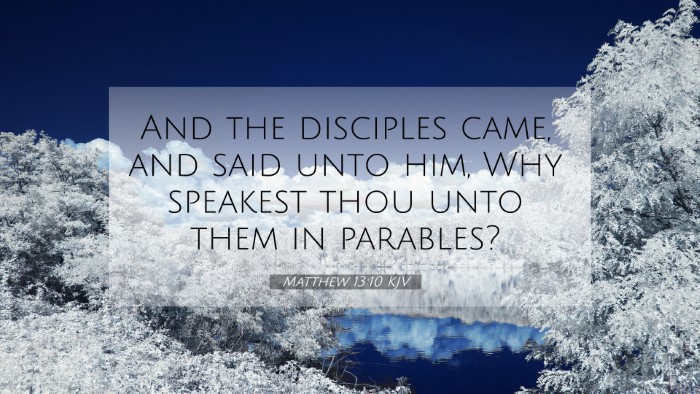Understanding Matthew 13:10
Matthew 13:10 states: "And the disciples came, and said unto him, Why speakest thou unto them in parables?" This verse raises important questions regarding the teaching methods of Jesus and the purpose behind using parables.
Context and Overview
In Matthew 13, Jesus begins to teach the crowds in parables, a method of instruction that employs simple stories with profound spiritual truths. The disciples’ question indicates their confusion and desire for clarity about why Jesus chose to convey His messages in this particular way.
Commentary Insights
-
Matthew Henry:
Henry emphasizes that parables can obscure meaning for those not willing to pursue understanding while revealing deep truths to those who are receptive. This technique aligns with the dual nature of Jesus' ministry, separating the curious from the committed.
-
Albert Barnes:
Barnes notes that parables serve as a way to speak to the masses while simultaneously conveying deeper truths to true followers, highlighting the need for spiritual insight to discern these truths.
-
Adam Clarke:
Clarke elaborates on the nature of parables, viewing them as an invitation for listeners to seek deeper meaning, thus emphasizing the engagement of the listener's heart and mind in the process of learning.
Significance of Parables
Parables function as vital teaching tools that engage listeners in a way that straightforward exposition does not. They are rich in metaphor and often require contemplation to uncover their significance.
Spiritual Implications
The use of parables can be seen as a divine strategy, fostering a desire for understanding among true seekers while also presenting a barrier to those indifferent to spiritual truths. This brings to mind several cross-references regarding Jesus' teaching style:
- Matthew 7:6 - "Give not that which is holy unto the dogs, neither cast ye your pearls before swine..."
- Mark 4:10-12 - Jesus explains the purpose of speaking in parables.
- Luke 8:10 - "Unto you it is given to know the mysteries of the kingdom of God..."
- Matthew 13:13 - The reason for speaking in parables is explained further.
- Isaiah 6:9-10 - A prophecy that speaks of hearing but not understanding.
- 1 Corinthians 2:14 - The natural man does not receive the things of the Spirit.
- Proverbs 1:5 - "A wise man will hear, and will increase learning..."
Thematic Connections to Other Verses
This verse also connects to broader themes within the Bible regarding knowledge and wisdom:
- Bible verse cross-references: Seeking knowledge through parables.
- Integrity of teaching: Jesus' method intentionally engages the heart.
- Divine revelation: The mystery of the kingdom revealed to seekers (Matthew 16:17).
- Faith's role: Hebrews 11:6 emphasizes that without faith, one cannot please God.
Tools for Bible Cross-Referencing
Engaging deeper with scripture often involves using tools and methods for Bible cross-referencing. These resources can enhance your understanding and provide greater clarity:
- Bible concordance: A tool that allows you to locate words and their occurrences throughout scripture.
- Bible cross-reference guide: Offers a systematic approach to finding verses that connect thematically or contextually.
- Bible chain references: Helps trace related scriptures across the text, forming a narrative thread.
- Cross-reference Bible study methods: Techniques that facilitate a comparative analysis of different scriptures related to a specific verse.
- Identifying connections: Understanding the dialogue between Old and New Testament scriptures.
How to Study Cross-References Effectively
To effectively study Bible verses in relation to Matthew 13:10, one can:
- Identify the core theme or question at the heart of the verse.
- Utilize a comprehensive Bible cross-reference system to find related scriptures.
- Engage in comparative Bible verse analysis to draw parallels.
- Reflect on the spiritual implications and what they reveal about God's character and purpose.
- Prepare for sermons or discussions by anchoring your insights in scripture references.
Conclusion
Matthew 13:10 encapsulates a critical aspect of Jesus' teaching approach and sparks a rich exploration of scripture. By utilizing the resources available for cross-referencing and connecting various Bible verses, believers can deepen their spiritual understanding and appreciation of God's Word.




